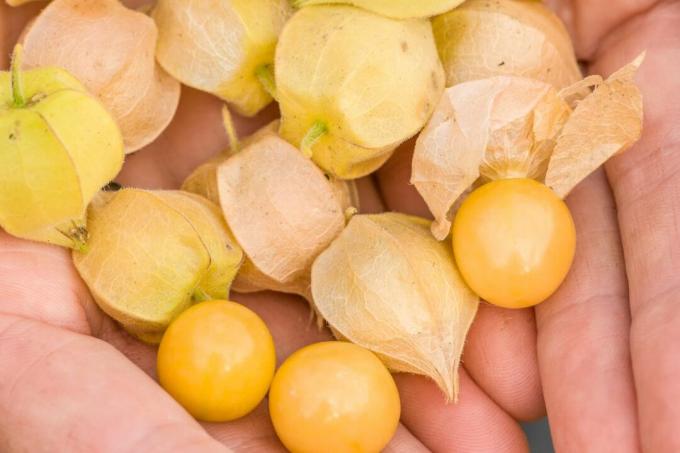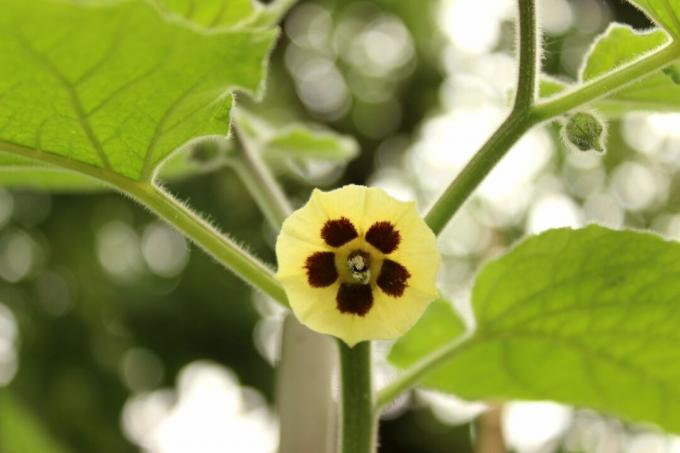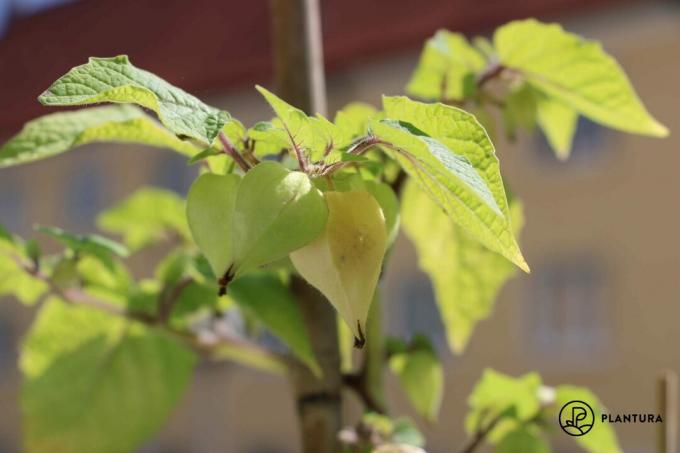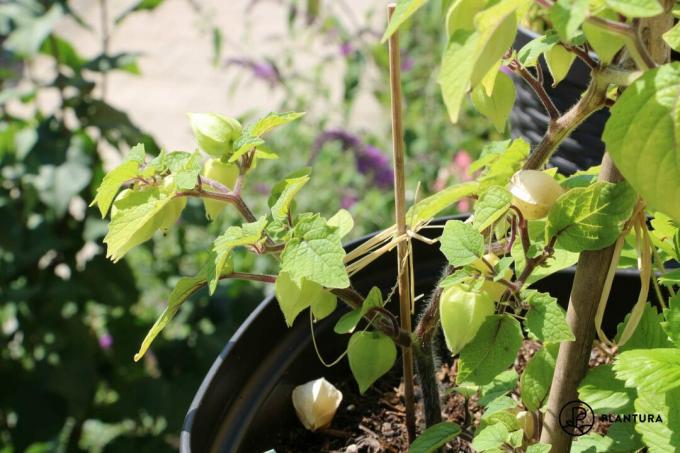The pineapple cherry is a bushy growing Physalis species with tasty fruits. Everything you should know about growing pineapple cherries can be found here.

The pineapple cherry (Physalis pruinosa) is a close relative of the Andean berry (Physalis peruviana), but is easier to cultivate in pots and has its very own, fruity-sweet and sour aroma. We present a portrait of the Physalis species and give you tips on growing the pineapple cherry.
contents
- Pineapple cherry: characteristics and origin
- The tastiest varieties
- Planting pineapple cherries: sowing, location and procedure
- Care of the earth cherry
- Hibernating pineapple cherries: is it hardy?
- Harvest: When are pineapple cherries ripe?
Pineapple cherry: characteristics and origin
The pineapple cherry, also called earth cherry or pineapple berry, belongs to the nightshade family (Solanaceae). Similar to their aubergine relatives (
Solanum melongena), Tomato (Solanum lycopersicum) and chilli (Capsicum) it comes from South America and is also found wild there. Also the kind Physalis pubescens is called earth cherry, but is offered far less often in this country. The slightly hairy, perennial plants reach an average height of 40 to 70 cm. Pineapple cherries branch out strongly and often become twice as wide as they are tall. On slightly angular, fluffy stems sit alternately heart-shaped to oval-round leaves with an irregularly serrated to wavy edge. The flowers, which have grown together from five petals, are pale yellow in color and have five dark points around the stamens. The flowering time of the pineapple cherry begins in May and continues into autumn. The up to 1.5 cm large and therefore cherry-sized berries develop inside a lantern after pollination. The first fruits ripen as early as June, when the fruits turn orange-yellow and the lantern cover dries. They fall to the ground when they are ripe and can be picked up. The sweet, fruity and slightly sour taste of the earth cherry can be described as a mixture between pineapple and citrus fruit.
What is the difference between pineapple cherry and andean berry? Compared to the Andean berries, the pineapple cherry grows much more bushy, only about half as high and at the same time significantly wider. The fruits are generally smaller than those of the Andean berries, but ripen earlier and often taste even more fruity.
The tastiest varieties
There are different varieties of pineapple cherries that differ mainly in terms of their fruit color, taste and height. All of the varieties mentioned here are seed-proof, which is why you can always extract pineapple cherry seeds from your own plants.
- ‘Annalisa‘: Pineapple cherry variety with medium-sized, golden-yellow fruits that fall from the plant ready for harvest as early as June. The plants grow bushy and reach heights of up to 70 cm.
- ‘Aunt Molly‘: Earth cherry of the species Physalis pubescens. This historic variety originally comes from Poland, where it was found at the beginning of the 19th century. Century. The medium to large, golden yellow berries are reminiscent of tangerine and pineapple in taste.
- ‘Geltower selection’ was bred for extra-large fruits. The aroma of this approximately 50 cm high pineapple cherry turns out to be extremely sweet and pineapple-like.
- ‘Goldie’ comes from the USA and makes particularly large, orange-colored berries with a taste reminiscent of pineapple and strawberry.
- ‘Gold marble‘: Earth cherry with about 1 - 1.5 cm large, golden yellow fruits. The taste is fruity and sweet. The plants of the pineapple cherry ‘gold marble are around 40 - 60 cm high and up to 120 cm wide.
- ‘Hermelinda‘: Pineapple cherry with cherry-sized, sweet and early ripening fruits. The plants reach heights of up to 70 cm and, compared to ‘Annalisa‘, grow more slowly, but more luxuriantly.
- ‘Izumii’ reaches a height of only 40 cm and thus finds space on every balcony. The approximately 1 cm large, light yellow berries taste strikingly sweet and fruity and ripen from July.

Planting pineapple cherries: sowing, location and procedure
The ideal location for Andean cherries is sunny, warm and on nutrient-rich, well-drained soils. In order to get an early harvest and to harvest as long as possible and as many fruits as possible, you should give preference to your pineapple cherry. The culture therefore begins in early spring with the cultivation on a warm, sunny window sill. The pineapple cherry is sown between February and March. The roundish, light brown seeds are Light germs, which is why they are covered with soil a few millimeters or not at all when sown. The germination time of the pineapple cherry is about 7 to 14 days. First sow the seeds of the earth cherry on a nutrient-poor growing medium and prick out the plants later when they form the first leaf after the cotyledons. Here you should convert the physalis into nutrient-rich plant substrate, as the nutrient requirement now increases sharply due to the growth.
From mid-May after the ice saints, the pineapple cherries can be planted outdoors. They can be cultivated equally in the greenhouse and in the bed. Bushy physalis can also be grown on the raised bed. To do this, dig a planting hole and place the earth cherry in it. When planting the pineapple cherry, you should make sure that the nightshade plants are not set deeper than they were in the pot before. A pre-fertilized potting soil - like ours Plantura organic tomato & vegetable soil - is suitable for pricking the young plants as well as for filling the final planters and for improving the soil in the greenhouse and bedding. Then water the plants vigorously after planting.
Keeping pineapple cherries in the pot? The bushy growing Physalis species is particularly suitable as a sweet fruit for terraces and balconies. To grow earth cherries in pots, the planter should hold at least 5 liters of soil and have good water drainage.
Tip: If you want to grow the pineapple cherry in mixed culture, you should not choose any close relatives as neighbors. Low-eating vegetables such as salads, spinach (Spinacia oleracea), but also bulbous plants (Allium), Beans (Phaseolus vulgaris) as well as cabbage family (Brassicaceae) and also Strawberries (Fragaria) are suitable as plant partners for earth cherries.

Care of the earth cherry
When caring for pineapple berries, special attention must be paid to the supply of water and nutrients. In summer, the plants should be watered sufficiently and regularly. From June onwards, the bushy pineapple berries benefit from fertilizers. An organic liquid fertilizer like ours Plantura organic tomato & vegetable fertilizer, supplies the nutrient-hungry berry plants with nitrogen and potassium. The weekly fertilization with the irrigation water is particularly user-friendly and is equally suitable for pineapple cherries in pots and beds.
The blooming plants are not exhausted. Depending on the height and as protection from strong winds or storms, despite their compact growth, they need a rod as a support. A layer of mulch, for example from lawn clippings, prevents evaporation on the one hand and serves as food for on the other Microorganisms and at the same time prevents ripe berries from lying on the ground and rot when they come off the bush fall. However, carbon-rich mulch materials can bind nitrogen when they decompose, which is why compensatory fertilization may be necessary.
Hibernating pineapple cherries: is it hardy?
The pineapple cherry is perennial, but can only overwinter without protection in frost-free areas with mild winters. For wintering in late autumn, the plants are cut back to about a third and then overwintered frost-free at at least 5 ° C with very sparing watering. Usually, however, earth cherries are cultivated as an annual, since overwintering is not necessarily one earlier and richer harvest and the plants in the winter quarters are easily attacked by diseases will. Especially the gray mold (Botrytis cinerea) poses a risk in excessively humid conditions. Therefore, annual sowing is often the better method to successfully grow pineapple cherries.

Harvest: When are pineapple cherries ripe?
Harvesting the pineapple cherry is very easy, because ripe fruits can be recognized by the fact that they fall to the ground. This is why the nightshade plant was also given its nickname earth cherry, as the fruits and lanterns are picked up from the ground. A single plant can bear more than 100 fruits. The fruity-sweet and fresh-sour taste of the pineapple cherry unfolds its full aroma best in shape of jam, dried or freshly dipped in chocolate as an edible decoration on sweet pastries or in Desserts. When stored in their lanterns at room temperature, pineapple berries can be kept for several weeks.
The one closely related to the pineapple cherry Andean berry we will present you in more detail in our special article.



